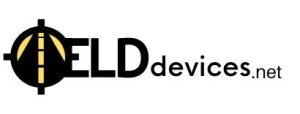WHAT IS ELD?
What does ELD stand for?
ELD stands for Electronic Logging Device. These devices are also commonly referred to as e-logs or electronic logbooks. Regardless of the name, ELDs are now mandatory in almost all commercial motor vehicles operating in both the United States and Canada.
An ELD is a hardware device that connects to a commercial vehicle’s engine to record specific data about its operation. This includes driving time, engine hours, vehicle movement, location, and more. While the ELD records data automatically, it relies on a paired tablet or smartphone to display information to the driver and support driver interaction with the system.
ELD Devices replaced the previously used AOBRDs (Automatic On-Board Recording Devices) and are now required under the FMCSA’s ELD mandate in the U.S. and the Canadian Council of Motor Transport Administrators (CCMTA) regulations in Canada.
To comply with the ELD mandate, any installed device must be listed on the FMCSA’s approved ELD registry or certified by an accredited third party in Canada.
So you may ask what is the purpose of this device and what does it do? Or, Do I need and ELD?
We are going to drive you through all you need to know about Electronic Logging Devices

Information recorded by ELD
Electronic Logging Devices (ELDs) automatically record key operational data from commercial vehicles. Their primary function is to document the driver’s Record of Duty Status (RODS), ensuring compliance with Hours of Service (HOS) regulations.
The most critical data point is the number of hours a truck is in operation. But that’s just the beginning — ELDs also track:
- When the vehicle is in motion
- The speed and distance traveled
- Engine hours and ignition status
- Idle time (when the vehicle is parked but the engine is running)
- Driver’s status (On Duty, Off Duty, Driving, Sleeper Berth)
- Vehicle location at regular intervals
- Transitions between duty statuses
This data is captured in real time, providing both drivers and fleet managers with accurate and tamper-resistant logs.

ELD Regulations
Commercial vehicles in Canada and United States are now fully transitioned from older AOBRD systems to Electronic Logging Devices (ELDs), as required by law. These regulations ensure consistent and tamper-resistant tracking of driver hours to improve road safety and reduce fatigue-related incidents.
In the United States, the Federal Motor Carrier Safety Administration (FMCSA) mandates that all commercial vehicles subject to Hours of Service (HOS) regulations must use FMCSA-registered ELDs. These devices are self-certified by manufacturers but must meet rigorous technical standards set by the FMCSA.
n Canada, ELDs must be certified by an accredited third-party body approved by Transport Canada. This added layer of verification is designed to prevent manipulation and ensure a higher level of compliance across fleets.
Though there are differences between U.S. and Canadian ELD rules — such as reporting formats and time zones — both countries have worked closely to standardize ELD usage, especially for fleets operating across the 80-plus commercial border crossings between the two nations.
Differences Between AOBRD and ELD
AOBRDs (Automatic On-Board Recording Devices) were the standard before ELDs became mandatory. Both connect to a vehicle’s engine to track Hours of Service, but ELDs are more advanced and secure.
Key differences:
Data Sync: ELDs sync directly with the vehicle’s engine control module (ECM), offering more accurate data.
Location Tracking: ELDs record vehicle location at regular intervals and during duty status changes.
Duty Status Updates: ELDs auto-switch to “On-Duty, Not Driving” after 5 minutes of inactivity with no driver input.
Tamper Resistance: ELDs include stricter safeguards against data manipulation.
Log Access: ELDs must provide digital logs for roadside inspections via Bluetooth, USB, or web services.
While AOBRDs are now phased out, some legacy systems may still resemble them. Ensure any current device is fully FMCSA or Transport Canada compliant.
Is an ELD the same as an EOBR?
No, an ELD is not the same as an EOBR.
An EOBR (Electronic On-Board Recorder) was a term used by the FMCSA in the early 2000s to describe any electronic device that recorded driving data. However, EOBRs had fewer technical requirements and were not standardized for data transfer or tamper resistance.
In 2012, the ELD mandate replaced the term EOBR. ELDs are now the official standard and must meet strict FMCSA or Transport Canada specifications.
If your fleet is still using a device once labeled as an EOBR, ensure it is certified and listed as a compliant ELD — otherwise, you may not meet federal requirements.
Specifications and Requirements
According to FMCSA regulations, an ELD must automatically switch to “Driving” status when the vehicle exceeds 5 mph. It must also record the following data:
Date and time
Location
Vehicle identification
Driver ID
Engine hours
Odometer readings
Carrier and user information
Duty status changes and annotations
The ELD must connect to the vehicle’s engine control module (ECM) to log movement and engine-related metrics. It must also provide logs in a standardized, tamper-resistant format.
To comply, ELDs must support data transfer via:
Wireless web services
Email
USB 2.0
Bluetooth
ELDs must retain records for at least 7 consecutive days and provide a digital display or printout on demand for roadside inspections. Drivers must also certify their logs every 24 hours.
Usage of Data recorded by ELD
The primary purpose of ELD data is to help enforce Hours of Service (HOS) rules and ensure driver safety. The FMCSA and Transport Canada use this data to confirm compliance during inspections and audits.
Beyond regulatory use, ELD data helps fleets improve safety, accountability, and efficiency:
Identify speeding and unsafe driving behavior
Detect excessive idling and fuel waste
Track unauthorized vehicle use
Evaluate engine performance through RPM, fuel usage, and torque data
Monitor route efficiency and delivery timelines
Fleet managers use these insights to coach drivers, reduce violations, prevent misuse of vehicles, and improve operational costs.
Though some industry voices raise concerns about overregulation, the goal of ELD data collection is to reduce fatigue-related crashes and promote safer roads.
What ELD Device MUST have?
To meet FMCSA or Transport Canada requirements, an ELD must connect to the vehicle’s engine and retrieve operational data directly from the ECM. The device must function without manual input and verify driving status automatically.
Required features include:
Automatic detection of driving, on-duty, and off-duty statuses
Real-time syncing with vehicle movement and engine activity
Standardized output format with data logs viewable via screen or print
Secure data transfer through wireless, Bluetooth, or USB methods
Tamper resistance and data retention for at least 7 consecutive days
Driver confirmation of logs every 24 hours
System alerts for missing or unverified data entries
Unlike older apps or paper logs, modern ELDs verify driver status based on vehicle motion. This eliminates falsified logs and ensures accurate, compliant reporting.
Important Features
A fully compliant ELD must offer features that simplify logging and improve accountability for both drivers and fleet managers. The following are essential:
Individual accounts for drivers and administrators
Automatic logging of driving time in 60-minute intervals
Real-time data syncing with the vehicle’s engine
Digital display or printout access for roadside inspections
Driver certification required every 24 hours
Secure data retention for at least seven consecutive days
Assignment of unidentified driving time to appropriate drivers
Full access for DOT and law enforcement during audits
These features ensure that the ELD not only meets federal requirements but also enhances safety, transparency, and operational oversight in any fleet.
ELD Reporting and Connectivity

ELDs must transmit data in a standardized format accessible to fleet managers, DOT officers, and law enforcement. There are four approved data transfer methods:
Web-based (wireless)
Cellular networks
Bluetooth 2.0
USB 2.0
Many modern ELDs now include built-in wireless hotspots. This allows not only for compliance reporting but also internet access via connected tablets or other mobile devices.
Fleet managers can use real-time connectivity to:
Monitor routes and delivery timeframes
Receive instant alerts for unsafe driving events
Access live vehicle diagnostics and engine fault codes
While Bluetooth and USB connections don’t provide live updates, they continue to log data during signal loss. As soon as connectivity is restored, the data is synced and made available for review.
How much does an ELD Device Cost?
The cost of ELD device can range between $240 to $700 a year per truck. The average cost of ELD device hoovers around $495 annually per truck.
For more information regarding the different costs check electronic logging devices comparison.
You can request a free consultation by filling the questionnaire below, a professional advisor will prepare a quote and the best ELD options for your business model.
Electronic Logging Device Exceptions
Not all commercial drivers are required to use ELDs. As of 2025, the FMCSA outlines four key exemptions:
1. Pre-2000 Engines
Vehicles with engines manufactured before the year 2000 are exempt, even if the truck itself is newer. The exemption is based strictly on the engine model year.
2. Drive-Away/Tow-Away Operations
Drivers transporting vehicles as part of the shipment (such as delivering a new truck) are not required to use ELDs in the towed or driven units.
3. Short-Haul Exemption
Drivers using the 150 air-mile (U.S.) or 160 km (Canada) short-haul exemption, and not required to keep RODS for more than 8 days in any 30-day period, do not need ELDs.
4. Daily Transport with Return to Home Base
Drivers who operate within a 100-mile radius and return to the same location daily may qualify as exempt, depending on their specific operations and log requirements.
Benefits of ELD Technology
ELDs improve safety, compliance, and operational efficiency across commercial fleets.
Key benefits include:
Accurate Records: Automated logs reduce human error and eliminate falsified entries.
Improved Road Safety: By enforcing HOS rules, ELDs help reduce driver fatigue and accident risk.
Simplified Compliance: Easy access to DOT-compliant logs for inspections and audits.
Operational Transparency: Fleet managers can track vehicle location, driver behavior, and idle time in real time.
Driver Protection: ELD logs prevent unfair scheduling and reduce harassment by documenting exact work hours.
Cross-Border Standardization: Harmonized rules between the U.S. and Canada support smoother international operations.
Modern ELDs also support features like real-time alerts, engine diagnostics, and AI dashcam integration—making them essential for efficient fleet management.


 Answer 5 simple questions to request a
Answer 5 simple questions to request a